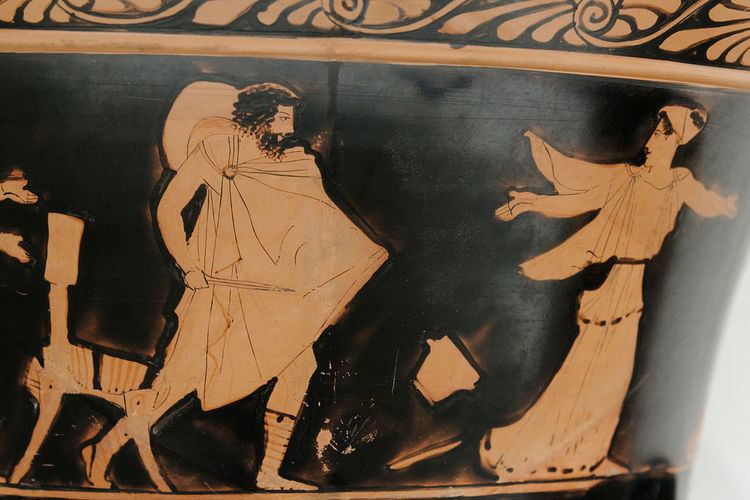 | ||
Circe (/ˈsɜːrsiː/; (Greek: Κίρκη Kírkē [kírkɛ͜ɛ]) is a goddess of magic (or sometimes a nymph, witch, enchantress or sorceress) in Greek mythology. By most accounts, she was the daughter of the sungod Helios, and Perse, an Oceanid. Her brothers were Aeetes, keeper of the Golden Fleece, and Perses. Her sister was Pasiphaë, the wife of King Minos and mother of the Minotaur. Other accounts make her the daughter of Hecate, the goddess of witchcraft.
Contents
Circe was renowned for her vast knowledge of potions and herbs. Through the use of these and a magic wand or a staff, she transformed her enemies, or those who offended her, into animals. Some say she was exiled to the solitary island of Aeaea by her subjects and her father Helios for killing her husband, the prince of Colchis. Later traditions tell of her leaving or even destroying the island and moving to Italy, where she was identified with Cape Circeo.
Artistic representations
In her survey of the Transformations of Circe, Judith Yarnall comments of this figure, who started out as a comparatively minor goddess of unclear origin, that “What we know for certain - what Western literature attests to – is her remarkable staying power…These different versions of Circe’s myth can be seen as mirrors, sometimes clouded and sometimes clear, of the fantasies and assumptions of the cultures that produced them.” After appearing as just one of the characters that Odysseus encounters on his wandering, "Circe herself, in the twists and turns of her story through the centuries, has gone through far more matamorphoses than those she inflicted on Odysseus's companions."
Depictions, even in Classical times, wandered away from the detail in Homer's narrative, which was later to be reinterpreted morally as a cautionary story against drunkenness. Early philosophical questions were also raised whether the change from a reasoning being to a beast was not preferable after all, and this paradox was to have a powerful impact in the Renaissance. In later Christian opinion, Circe was an abominable witch using miraculous powers to evil ends. When the existence of witches came to be questioned, she was reinterpreted as a depressive suffering from delusions. Circe was also taken as the archetype of the predatory female until her cause was taken up by women authors, who raised the question of whether this view had more to do with male fantasies than with the truth.
Western paintings established a visual iconography for the figure, but also went for inspiration to other stories concerning Circe that appear in Ovid's Metamophoses. The episodes of Scylla and Picus added the vice of violent jealousy to her bad qualities and made her a figure of fear as well as of desire. Later male interpretations were to take the metamophoses she inflicted not just as reflecting a temptation to bestiality but as an emasculatory threat.
Scientific interpretations
In botany the Circaea are plants belonging to the enchanter's nightshade genus. The name was given by botanists in the late 16th century in the belief that this was the herb used by Circe to charm Odysseus' companions. Medical historians have speculated that the transformation to pigs was not intended literally but refers to anticholinergic intoxication. Symptoms include amnesia, hallucinations, and delusions. The description of "moly" fits the snowdrop, a flower that contains galantamine, which is an anticholinesterase and can therefore counteract anticholinergics.
